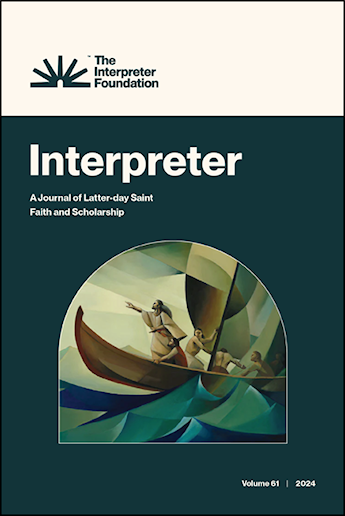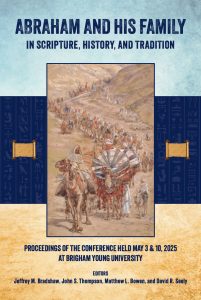[Page 49]Authors inevitably make assumptions about their readers as they write. Readers likewise make assumptions about authors and their intentions as they read. Using a postmodern framing, this essay illustrates how a close reading of the text of 1 and 2 Nephi can offer insight into the writing strategies of its author. This reading reveals how Nephi differentiates between his writing as an expression of his own intentions and desires, and the text as the product of divine instruction written for a “purpose I know not.” In order to help his audience understand the text in this context, Nephi as the author interacts with his audience through his rhetorical strategy, pointing towards his own intentions, and offering reading strategies to help them discover God’s purposes in the text. Continue reading
 Welcome to Interpreter: A Journal of Latter-day Saint Faith and Scholarship, the peer-reviewed journal of The Interpreter Foundation, a nonprofit, independent, educational organization focused on the scriptures of The Church of Jesus Christ of Latter-day Saints. Non-print versions of our journal are available free of charge, with our goal to increase understanding of scripture. Our latest papers can be found below.
Welcome to Interpreter: A Journal of Latter-day Saint Faith and Scholarship, the peer-reviewed journal of The Interpreter Foundation, a nonprofit, independent, educational organization focused on the scriptures of The Church of Jesus Christ of Latter-day Saints. Non-print versions of our journal are available free of charge, with our goal to increase understanding of scripture. Our latest papers can be found below.
Interpreter's Mission Statement →
Read the journal →
Learn more about the Board →
Find out how you can donate →
Contact the Editorial Board →

Church History and Great Britain with the Interpreter Foundation 14-Day Land Tour escorted by Dan Peterson, Kristine Frederickson, and Peter Fagg May 6-19, 2026 This tour will sell out fast so book your reservation now! Go to https://interpreterfoundation.org/study-travel/britains-2026/ for more information |
|
Abraham and His Family in Scripture, History, and Tradition Proceedings of the Conference held May 3 & 10, 2025 at Brigham Young University Sponsored by The Interpreter Foundation, Edited by Jeffrey M. Bradshaw, John S. Thompson, Matthew L. Bowen, & David R. Seely Published by The Interpreter Foundation and Eborn Books For more information, go to https://interpreterfoundation.org/books/abraham-and-his-family/ |
|
Call for Proposals “For a Wise Purpose in Him” Perspectives on the Small Plates of Nephi A Conference on the Small Plates of Nephi in the Book of Mormon May 29-30, 2026 Sponsored byThe Interpreter Foundation Go to https://interpreterfoundation.org/conferences/2026-small-plates-of-nephi/ for more information |
Inattentional Blindness: Seeing and Not Seeing The Book of Mormon
[Page 33]Review of Earl M. Wunderli, An Imperfect Book: What the Book of Mormon Tells Us about Itself (Salt Lake City: Signature Books, 2013), 328pp + Appendices, Maps, and Index.
Earl Wunderli, an attorney who has made a lifelong study of the Book of Mormon, concludes that the book is a product of Joseph Smith’s mind and imagination. In doing so, Wunderli marshals evidence and presents his argument as if he were an attorney defending a client in court. Unfortunately, Wunderli’s case suffers from the same weaknesses and limitations of other naturalist criticism in that it exaggerates Joseph Smith’s intellectual and cultural background and compositional skills while ignoring the Book of Mormon’s deep structure, narrative complexity, and often intricate rhetorical patterns. Continue reading
The Book with the Unintentionally Self-Referential Title
[Page 1]Review of Earl M. Wunderli, An Imperfect Book: What the Book of Mormon Tells Us about Itself (Salt Lake City: Signature Books, 2013), 328pp + Appendices, Maps, and Index.
Earl M. Wunderli has written a book that works through the reasons he fell out of belief in the Book of Mormon. These are combined with issues that he has added to his original reasons. His presentation is clearly intended to suggest that what he found compelling will also be compelling to other readers. Should it? This review looks at how his arguments are constructed: his methodology, the logic of the analysis, and the way he uses his sources. Although he argues that it is the Book of Mormon that is the imperfect book, his construction of the arguments makes that designation ironic. Continue reading
The Sibling Scandals of the Resurrection
[Page vii]I’ve recently picked Stephen T. Davis’s Risen Indeed: Making Sense of the Resurrection up again.1 It’s an impressive book that had a pivotal effect on my thinking when it first appeared. Davis, the Russell K. Pitzer Professor of Philosophy at Claremont McKenna College in California, argues that “Christians are within their intellectual rights in believing that Jesus was raised from the dead.”2 “The thesis of the book,” he explains, “is that the two central Christian resurrection claims — namely, that Jesus was bodily raised from the dead and that we will all be raised from the dead — are defensible claims.”3 Continue reading
A Look at Some “Nonstandard” Book of Mormon Grammar
[Page 209]Abstract: Much of the earliest Book of Mormon language which has been regarded as nonstandard through the years is not. Furthermore, when 150 years’ worth of emendations are stripped away,1 the grammar presents extensive evidence of its Early Modern English character, independent in many cases from the King James Bible. This paper argues that this character stems from its divine translation. Continue reading
Big Trouble in River City: American Crucifixion and the Defaming of Joseph Smith
[Page 177]Review of Alex Beam. American Crucifixion: The Murder of Joseph Smith and the Fate of the Mormon Church. PublicAffairs, 2014. 352 pp.
Abstract: On April 22, 2014, PublicAffairs, an imprint of a national publisher Persues Books Group, released American Crucifixion: The Murder of Joseph Smith and the Fate of the Mormon Church, authored by Alex Beam. Beam, who openly declared he entered the project without personal biases against Joseph Smith or the Latter-day Saints, spent a couple of years researching his work, which he declares to be “popular non-fiction” and therefore historically accurate. This article challenges both of these assertions, showing that Beam was highly prejudiced against the Church prior to investigating and writing about events leading up to the martyrdom. In addition, Beam’s lack of training as an historian is clearly manifested in gross lapses in methodology, documentation, and synthesis of his interpretation. Several key sections of his book are so poorly constructed from an evidentiary standpoint that the book cannot be considered useful except, perhaps, as well-composed historical fiction. Continue reading
Changes in The Book of Mormon
[Page 161]Author’s preface: I originally gave this presentation in August 2002 at the LDS FAIR conference held in Orem, Utah. A transcript of this paper, based on the 2002 version, appears online at www.fairmormon.org. Since then I have published updated versions of the first half of that original presentation. The most recent history of the Book of Mormon critical text project can be found in my article “The Original Text of the Book of Mormon and its Publication by Yale University Press”, published in 2013 in Interpreter: A Journal of Mormon Scripture, volume 7, pages 57-96. Until now, I have not published a printed version of the second half of my original presentation, “Changes in the Book of Mormon”.
Abstract: In that part of the original article (here presented with some minor editing), I first describe the different kinds of changes that have occurred in the Book of Mormon text over the years and provide a fairly accurate number for how many places the text shows textual variation. Then I turn to five changes in the text (“the five chestnuts”) that critics of the Book of Mormon continually refer to. At the conclusion of the original article, I provide some specific numbers for the different types of changes in the history of the Book of Mormon text, including the number of changes introduced in The Book of Mormon: The Earliest Text, the definitive scholarly edition of the Book of Mormon, published in 2009 by Yale University Press. Continue reading
Understanding Nephi with the Help of Noah Webster
[Page 97]Abstract: Dictionaries, especially Noah Webster’s 1828 American Dictionary of the English Language, can be useful and informative resources to help us better understand the language of the Book of Mormon. This article compares definitions of words and phrases found in the book of 1 Nephi, using Webster’s 1828 dictionary and the New Oxford American Dictionary as references. By comparing these two dictionaries, we can see how word usage and meanings have changed since the original publication of the Book of Mormon in 1830. We can also gain a greater appreciation of the text of the Book of Mormon in a way that its first readers probably understood it. Continue reading
“War of Words and Tumult of Opinions”: The Battle for Joseph Smith’s Words in Book of Mormon Geography
[Page 37]Review of John L. Lund. Joseph Smith and the Geography of the Book of Mormon. The Communications Company, 2012. 209 pp. + xviii, including index.
In the midst of this war of words and tumult of opinions, I often said to myself: What is to be done? Who of all these parties are right; or, are they all wrong together? If any one of them be right, which is it, and how shall I know it?
–Joseph Smith Jr.1
Over the years, a plethora of theories have been advanced regarding the geography of the Book of Mormon.2 No doubt that many Latter-day Saints who have inquired on the subject have felt much like the young Joseph Smith: caught between a “war of words and tumult of opinions,” he or she wonders “What is to be done? Who of all these parties are right; or, are they all wrong together?” And how is one to know; how does one go about trying to judge between the competing views? Continue reading
Getting into the Meat of the Word of Wisdom
[Page 1]Abstract: In verse 13 of the Word of Wisdom, the Lord tells us, “it is pleasing unto me that they [flesh of beasts and fowls of the air] should not be used, only in times of winter, or of cold, or famine” (D&C 89:13). Judging from the variety of interpretations this single verse has inspired, it would appear to be deeply enigmatic. Interestingly, most interpretations have been put forward with little supporting evidence. This article is the first comprehensive analysis of the diverse explanations for D&C 89:13 that have been suggested since 1833. In this article, I attempt to analyze these various interpretations in light of the available evidence. Continue reading
Reading the Scriptures Geographically: Some Tools and Insights
[Page 257]Abstract: The purpose of this article is to provide several examples of how meaning, understanding, and interpretation of scriptures may be enhanced when scriptures are read in their geographical context. Many scholarly articles seek exclusively to break new ground in meaning and meaning-making, to essentially produce new knowledge. This article hopes to break new ground both in terms of new knowledge (insights) as well as in the pragmatics of giving readers additional tools and opportunities for exploring the scriptures in fresh ways. In particular, this article will also highlight several free geographical tools that can improve one’s learning with the scriptures, with particular focus on Google Earth and the BYU scriptures.byu.edu/mapscrip tool (hereafter referred to as Google Earth Bible or GEB). The hope is that this article will, through the tools discussed, create opportunities for others to create new knowledge for themselves through scripture study. Continue reading
Some Notes on Faith and Reason
[Page vii]Philosophers and theologians, believers and unbelievers, friends to faith and enemies, scientists, historians — these and many others have devoted a very great deal of time and attention for centuries to the relationship between faith and reason.
There is little if any general consensus on the matter, and I have no intention, in just a few pages here, of trying to settle things. I’m inclined, though, to share a few thoughts on the topic from my Latter-day Saint perspective. Continue reading
Restoration: A Theological Poem in the Book of Mormon
[Page 239]Abstract: The distinctive Mormon conception of God makes possible a logically coherent reconciliation of the facially incompatible laws of justice and mercy. The Book of Mormon prophet Alma clearly explains how these two great laws may be reconciled through the atonement and repentance that the atonement makes possible. Alma artfully illustrates the relationship between justice and mercy in a carefully crafted theological poem. Continue reading
Eye of the Beholder, Law of the Harvest: Observations on the Inevitable Consequences of the Different Investigative Approaches of Jeremy Runnells and Jeff Lindsay
[Page 175]Review of “Letter to a CES Director: Why I Lost My Testimony,” Jeremy Runnells, April 2013, Updated February 23, 2014. 83 pages. http://cesletter.com/Letter-to-a-CES-Director.pdf.
Abstract: In his Letter to a CES Director, Jeremy Runnells explains how a year of obsessive investigation brought about the loss of his testimony. In an LDS FAQ, LDS blogger Jeff Lindsay deals with all of the same questions, and has done so at least twenty years and has not only an intact testimony, but boundless enthusiasm. What makes the difference? In the parable of the Sower, Jesus explained that the same seeds (words) can generate completely different harvests, ranging from nothing to a hundred-fold increase, all depending on the different soil and nurture. This essay looks at how different expectations and inquiries for translation, prophets, key scriptural passages on representative issues can lead to very different outcomes for investigators. Continue reading
Mormonism and Intellectual Freedom
[Page 161]Abstract: To many outside the Church of Jesus Christ of Latter-day Saints (and to some of its members), the Church’s teachings and practices appear not only socially and experientially constraining, but intellectually restrictive as well, given its centralized system of doctrinal boundary maintenance and its history of sometimes sanctioning members who publicly dissent from its teachings. Do these practices amount to a constraint of intellectual freedom? This essay argues that they do not, and offers several possible explanations for the commonly-asserted position that they do. Continue reading
“And There Wrestled a Man with Him” (Genesis 32:24): Enos’s Adaptations of the Onomastic Wordplay of Genesis
[Page 151]Abstract: In this brief note, I will suggest several instances in which the Book of Mormon prophet Enos utilizes wordplay on his own name, the name of his father “Jacob,” the place name “Peniel,” and Jacob’s new name “Israel” in order to connect his experiences to those of his ancestor Jacob in Genesis 32-33, thus infusing them with greater meaning. Familiarity with Jacob and Esau’s conciliatory “embrace” in Genesis 33 is essential to understanding how Enos views the atonement of Christ and the ultimate realization of its blessings in his life. Continue reading
Questioning the Comma in Verse 13 of the Word of Wisdom
[Page 133]Abstract: The 1921 edition of the Doctrine and Covenants included an additional comma, which was inserted after the word “used” in D&C 89:13: “And it is pleasing unto me that they should not be used, only in times of winter, or of cold, or famine.” Later authors have speculated that the addition of the comma was a mistake that fundamentally changed the meaning of the verse. This article examines this “errant comma theory” and demonstrates why this particular interpretation of D&C 89:13 is without merit. Continue reading
A Scientist Looks at Book of Mormon Anachronisms
[Page 123]Review of Wade E. Miller, Science and the Book of Mormon: Cureloms, Cumoms, Horses & More (Laguna Niguel, California: KCT & Associates, 2010). 106 pages + viii, including two appendices and references cited, no index.
Abstract: Anachronisms, or out of place items, have long been a subject of controversy with the Book of Mormon. Several Latter-day Saints over the years have attempted to examine them. Dr. Wade E. Miller, as a paleontologist and geologist, offers a some new insights on this old question, especially regarding animals mentioned in the Book of Mormon, including a report on some preliminary research which might completely change the pre-Columbian picture for horses in America. Overall, this is an indispensable resource on Book of Mormon anachronisms.
Dissenters: Portraying the Church as Wrong So They can be Right Without It
[Page 77]Abstract: This essay addresses the reasons many persons have left The Church of Jesus Christ of Latter-day Saints. In particular, there are those who publicly assert the Church is not led by inspired leaders so they can feel at peace about their decision to leave it. One common argument used to justify their estrangement is the “Samuel Principle,” which ostensibly would require God to allow his followers on earth to go astray if they chose any level of unrighteousness. Problems with this interpretation are presented including examples from religious history that show that God’s primary pattern has been to call his errant followers to repentance by raising up righteous leaders to guide them. Also explored are the common historical events that dissenters often allege have caused the Church to apostatize. The notion that the Church and the “Priesthood” could be separate entities is examined as well. The observation that Church leaders continue to receive divine communication in order to fulfill numerous prophecies and that a significant number of completely devout Latter-day Saints have always existed within the Church, obviating the need for any dissenting movement, is discussed. In addition, several common scriptural proof-texts employed by some dissenters and their ultimate condition of apostasy are analyzed. Continue reading
Separated but not Divorced: The LDS Church’s Uncomfortable Relationship with its Polygamous Past
[Page 45]Abstract: The Church of Jesus Christ of Latter-day Saints’s uncomfortable relationship with its polygamous history is somewhat like an awkward marriage separation. This is, in part, because of the fitful, painful cessation of plural marriage and the ever present reminders of its complicated past. This essay looks at examples of members’ expression of discomfort over a polygamous heritage and concludes with suggestions of possible pathways to a more comfortable reconciliation. Continue reading



 Conference Proceedings are now available
Conference Proceedings are now available